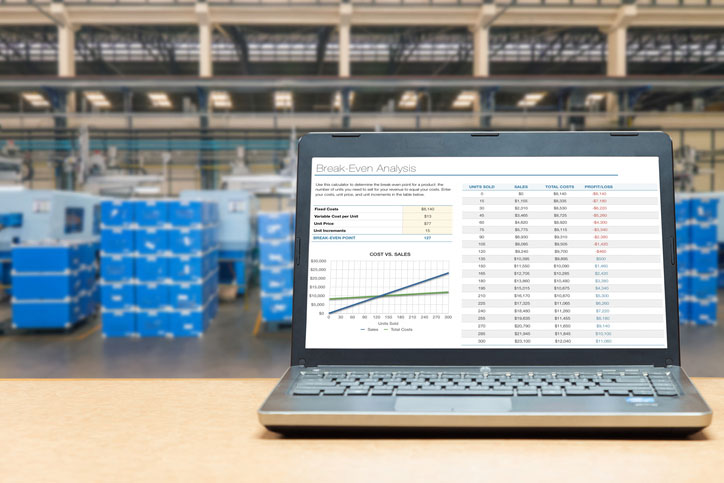Written by Scott Wilson

Everyone knows today how critical supply chain management is to business, government, and the fabric of modern society. It’s a topic covered in every business degree taught today. It’s front and center in geopolitics, and the field of economics sometimes obsesses over it.
But how do we know that supply chain management is so important? And what is it that makes it a competitive game-changer for organizations that master it?
The answer is supply chain planning and analysis.
Providing the Data and Details That Make Supply Chain Management a Force in the Modern World
Much of what has made the supply chain so powerful has been the new ability to glean insights from data and relationships that were previously inaccessible. For most of the history of organized commerce, companies could only count on a handful of signals about the state of their supply chain. They could know for certain if people were getting their products, and if their raw materials were available from suppliers. But going a level beyond was basically impossible… if your supplier’s supplier was having supply problems, you might not know until your crucial shipments dried up.
But new technologies have changed, and continue to change, how businesses gain visibility throughout their supply chain.
Not only is there an unprecedented amount of information available about global economics, but the tools to process that information have become enormously powerful.
Like many other parts of the supply chain, the roles that generate those analyses and strategies involve a great deal of specialized knowledge and skill. And like other roles in the field, they have their own unique tracks for education and employment.
How Supply Chain Management Analysis and Planning Jobs Fill the Needs of Organizations Large and Small

Without planning, supply chain management isn’t management at all… it’s a free-for-all. And without data and analysis, planning is just a stab in the dark.
Organizations of all sizes in every industry must engage in supply chain analysis and planning.
In smaller companies, that may mean the warehouse manager must double up on their regular work and spend afternoons reviewing Excel spreadsheets. At major organizations, entire departments are devoted to strategy and analysis. Dedicated specialists in every aspect of the supply chain work together, using advanced programming and software tools to uncover global trends.
Planning and analytics positions in supply chain management tend to fall into two buckets:
Analysts
These are the researchers responsible for collecting, collating, and evaluating data on all aspects of the company’s supply chain. They engage in both open-source market research, such as production and pricing data from suppliers, as well as examining proprietary data on logistics performance and patterns within the company. They may also engage in more wide-ranging predictive work, evaluating trends in areas ranging from climate change to petroleum production. Any aspect of global trade or politics that might influence supply chain operations is fair game for developing reports and recommendations
Planners
Managers at more senior levels both oversee and direct analysts in their research efforts, putting their advanced training to use in developing strategic plans from that information. These are usually jobs that require higher levels of education, such as master’s degrees in supply chain management. They require a deep understanding of supply chain processes and the business environment.
These roles are primarily office based. No one is going to ask you to go out and inspect shipping containers yourself. It’s a world of data and programming. Excel spreadsheets and an intimate familiarity with ERP (Enterprise Resource Planning) software packages are important.
Whether working at a big or a small company, though, your best resource for learning how to handle those tasks will be through a college degree.
What Types of Supply Chain Management Degrees Are Best for Strategy and Analysis Careers?

Analytics and strategic planning aren’t subjects for beginners in supply chain management. Consequently, they tend to go to some of the most highly educated candidates. A Bachelor of Science in Supply Chain Management is standard for entry-level work. Master’s degrees are preferred for higher-level positions.
Degrees such as an MBA in Supply Chain Management are particularly useful in analytics and planning roles.
First, since the MBA is a more general business degree, it comes with the kind of broad organizational and economic training that helps anchor the supply chain to overall corporate strategies. An MBA grad instinctively understands the need to find alignment between corporate goals and supply chain realities.
Second, the MBA is a practical degree program that nonetheless is heavily steeped in research and analysis work. Almost all MBA degrees include capstone projects that stress performing the hard work of breaking down multi-factor business problems and developing creative solutions.
That is exactly the work that strategic planners in supply chain management perform.
You can even find degrees like an MBA in Supply Chain Analytics that offer a particular focus in the analytical side of SCM.
Specialized Degrees in Analysis and Planning Deliver Focused Training

There are also many specialized programs that address strategy and analysis. A Master of Science in Supply Chain Management with a Concentration in Analytics delivers focused skills and knowledge in mathematical modeling, optimization theory, and even programming for data analysis.
You’ll also find options that come at supply chain analytics from outside the logistics box. A Bachelor of Business Analytics with a specialization in Supply Chain Analysis puts qualitative and quantitative analytical techniques first, with SCM considerations on top.
Degrees like a Master of Science in Operations and Supply Chain Analytics even deliver some crossover training between the analytical and operational side of the business.
There are also certificate programs, like a Supply Chain Analytics Certificate, that help established supply chain professionals brush up on the analytical side of the business. These programs are short, coming in well under a year, and less expensive than a full degree. Yet they often take on the latest and most in-depth developments in the business, as with a Post-Graduate Certificate in Strategic Supply Chain Management with AI.
Looking at the Coursework That Comes with a Supply Chain Management Degree in Planning and Analysis

Whether you’re on the degree or the certificate route to a supply chain management career in planning and analysis , you can expect a curriculum that dives deep into the technical details. A full degree program will usually include general coursework in supply chain management, including:
- Procurement and Vendor Negotiations
- Storage and Warehouse Management
- Transportation Processes and Packaging
- Inventory Management
- Operations and Process Automation
Associate and bachelor’s programs will also include general liberal arts coursework designed to expand your overall knowledge and critical thinking skills. Master’s and MBA programs will go the other direction, throwing in more focused and advanced courses in business administration and leadership.
For analysis and strategy education, though, expect to get some tough courses in subjects like:
Foundations of Business Analytics
A strong education in the statistical and mathematical foundation of analysis will polish your quantitative and qualitative reasoning skills. Don’t forget your calculator in these stats-heavy courses. But do stay awake to gain the confidence to make calculations the entire business can rely on.
Demand Forecasting
The art of seeing the future is critical for business innovation. Learn how to use open and closed-source data to forecast demand and predict shortages in time to adjust your strategy.
Risk Management
Analysts are on the front lines when it comes to reducing the things that can go wrong in a supply chain. This coursework can cover everything from spikes in fuel prices to Pacific tsunamis that may throw a wrench in your flow of supplies.
Quality Management
All the materials and the fastest delivery in the world isn’t much good if products aren’t meeting customer quality standards. Supply chain analysts and strategists learn how to establish those standards and ensure they are being met through these classes.
Inventory and Production Optimization
Creating a strategic advantage through supply chain management often involves slicing minutes off a delivery process or fractions of a cent out of storage costs. These classes teach you how to evaluate processes, fine-tune and optimize them for maximum efficiency and competitive advantage.
Strategic Coordination in SCM
Tying together logistics with business finance, marketing, and manufacturing units is the final piece of strategic supply chain management. This coursework lays the groundwork for you to make big-picture assessments and decisions to turn your SCM analysis into actionable strategies for the entire organization.
There will also be plenty of electives to choose from to hone your analytical skills. Everything from R language programming to sustainability considerations in global supply chains can add to your individual expertise as an analyst and planner.
Most SCM degrees in planning and analytics will also include some sort of field experience. An internship or a class research assignment that takes you out to a company meeting real demands every day helps match your theoretical training to the messy reality. And it hones your expertise so you can step up immediately when you’re on the job.
Professional Certifications Can Be an Important Part of Supply Chain Planning and Analysis Careers

An education in supply chain analytics and strategy is a great start to a career in this field. But you’ll also find that a lot of employers look for something more: professional certifications that extend and validate your expertise.
A professional certification is different from a certificate in that it doesn’t just provide knowledge; it tests your actual skills. That can include some training, but also:
- Testing
- Verified professional experience
- References
- Educational attainment
There are several professional certifications that can apply to strategy and analytics.
- ISM CPSM® (Certified Professional in Supply Management®) - The Institute for Supply Management is a heavyweight in SCM circles, and their premier certification, the CPSM®, includes competency assessment in areas like quality management, risk and compliance, and financial analysis.
- ASCM CPIM (Certified in Planning and Inventory Management) - The Association for Supply Chain Management combines internal inventory management with process improvement and planning assessment in the CPIM.
- Six Sigma - Six Sigma is a cross-industry manufacturing and operations process improvement certification. Offered through a variety of certifying bodies, the Black Belt level includes important validations of assessment and quality improvement skills used in supply chain analysis.
- PMI PMP® (Project Management Professional) - Supply chain planners can always use strong project management skills. The Project Management Institute’s PMP® lets employers know you have them. Assessing your skills with project management tools and tracking and monitoring, this certification combines planning and analysis competencies.
- ERP Certifications - Many planning and analysis professionals spend most of their time navigating ERP, or Enterprise Resource Planning, software. So, a vendor certification in the tools used by your organization can be invaluable, like the Oracle Procurement Cloud Certification or one of the SAP Digital Supply Chain Certifications.
Picking the right degree may even lay the groundwork for some of these important credentials. Many schools offer minors or course sequences designed to fulfill educational requirements for certs like the Six Sigma series.

Of course, picking the right degree also involves picking the right school. A degree with the right specialization is only the start. You’ll want to consider important factors such as:
- Instructor experience and qualifications
- Industry connections and networking opportunities
- Academic support and resources
- Counseling and advising services
- Specialty accreditation in the field of business, if eligible
Since efficiency is also something that supply chain managers in planning and analysis tend to think about, you’ll surely be considering cost when making your decision. According to the National Center for Education Statistics, the average annual cost of undergraduate programs at a four-year university is $17,251. For graduate degrees, it’s $19,749.
Exploring Online Degree Options in Supply Chain Planning and Analysis
Technology hasn’t just revolutionized supply chain management analysis and planning. It’s also completely changed how you earn degrees in the field.
Like logistics today, online degrees happen 24/7, and from anywhere in the world.
- With the location where you study entirely separated from the location of the school, you can save money and keep your life on track by learning from home.
- Learning management systems that are available at all hours allow you to take your classes and complete your work at any time, leaving you free to hold down a current job or take care of family concerns.
- Constant connection to classmates and professors with video streaming, real-time chat, and e-mail keeps you plugged in to what’s going on and to important study resources.
Roles and Responsibilities in Supply Chain Management for Planning and Analytics Experts
Supply chain analysts and planners will find their special talents are needed in every industry. Even straightforward businesses like agriculture or simple product manufacturers can have complex supply chains nowadays.
Analytics Can Untangle Major Supply Chain Knots

Although 3M is a massive company, many of their products are deceptively simple. Take the common and popular Command adhesive picture hook. A lightweight plastic hook with a removable sticky backing, it takes only seconds to put up.
Yet when supply chain analysts reported back to management about the process to make these basic hooks, jaws dropped. It turned out that the production process for a hook took over 100 days, sending the hook on a 1,300-mile odyssey to four different factories in four different states before being packaged and sent on to store shelves. At one of the factories, the primary process was simply stamping hooks with the 3M logo and slicing the material to size.
Armed with that information, planners at the company were able to drop the cycle time from 100 down to only 35 days.
The most common job title for these experts, by far, is simply Supply Chain Analyst. In some cases, more specific focus areas will turn up titles like Continuous Improvement Specialist, Inventory Analyst, or Acquisition Logistics Analyst.
Supply chain analysts perform tasks such as:
- Developing and tracking key performance indicators in supply chain operations
- Investigating new technologies or techniques in SCM to apply to business processes
- Cultivating sources of information on suppliers, producers, and vendors
- Managing information systems that track inventory and quality data
- Creating standards and requirements in logistics and storage
Those tasks sometimes bleed over into the strategic administration and management of the business. That adds responsibilities like:
- Production and delivery scheduling
- Supplier evaluation and performance reviews
- Process evaluation and redesign
- Supervising analytics and planning departments
These more senior roles often have job titles that reflect those responsibilities, such as:
- Supply Chain Analytics Manager
- Manufacturing Planner
- Global Supply Planner
- Supply Chain Demand Planner
At some level, that kind of decision-making becomes essential to the management of any organization. So, this is a career path that can lead you to the C-suite with the right education and experience under your belt.
Analyzing Salaries Available for Strategic Supply Chain Planners and Logisticians

The combination of skills and responsibilities for logistics and strategy experts in supply chain management generally lands them in one of two categories used by the Bureau of Labor Statistics for tracking salary levels. Those categories, and their pay rates for 2022, are:
- Logisticians - This group includes both entry-level and senior analysts in supply chain management, including analytics managers. The median salary was $77,520 for this group, but those in the top ten percent could earn more than $122,390.
- Top Executives - A broad category that takes in senior management in all kinds of business functions, top execs are the real decision-makers. They are the managers and executives who are responsible for developing and executing business strategy. Consequently, their base compensation was $98,980, with the top ten percent pulling down more than $208,000 annually.
The real exciting number for logisticians is this one, though: 28 percent. That’s the BLS-estimated growth rate for the position over the next decade. And it far outstrips the average rate of growth for American jobs.
As any analyst can tell you, high demand leads to higher salaries. So, the already generous compensation that supply chain analysts and strategists pull down today is only likely to go up.
2022 US Bureau of Labor Statistics salary and employment figures for Top Executives and Logisticians reflect national data, not school-specific information. Conditions in your area may vary. Data accessed July 2023.







